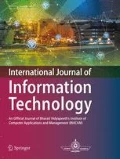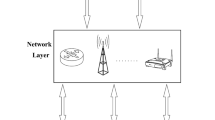Abstract
Internet of things (IoT) contains a massive number of “things” that are connected to the internet and communicates without human interaction. In these IoT devices, Radio frequency identification is used to detect the location of devices in communication networks. However, the RFID tag contains a low power battery and low memory capacity (i.e., few KB). Hence, it requires a lightweight or ultra-lightweight solutions for these RFID tags. This paper proposes a novel ultra-lightweight authenticate approach for a passive tag that uses XOR and rotate operations. This scheme contains three different phases: tag identification, mutual authentication, and pseudonyms and key updating phases. The first phase comprises the identification of the tag. After that, the second phase performs mutual authentication between the tag and the reader. The last phase involves the updating of the key between the tag and the reader. This scheme also defines the function “MIX” to enhance the security of the protocol. This scheme analyses in terms of communication cost between tag and reader, and storage cost for a passive tag.


Similar content being viewed by others
References
Gartner (2015) Gartner Says 6.4 Billion Connected “Things” Will Be in Use in 2016, Up 30 Percent From 2015. https://www.gartner.com/en/newsroom/press-releases/2017-02-07-gartner-says-8-billion-connected-things-will-be-in-use-in-2017-up-31-percent-from-2016. Accessed 23 Feb 2021
Greengard S (2015) Smart transportation networks drive gains. Commun ACM 58(1):25. https://doi.org/10.1145/2686742
Fang X, Misra S, Xue G, Yang D (2012) Smart grid—the new and improved power grid: a survey. IEEE Commun Surv Tutor 14(4):944. https://doi.org/10.1109/SURV.2011.101911.00087
Cocchia A (2014) In: Smart city. Springer, pp 13–43. https://doi.org/10.1007/978-3-319-06160-3_2
Ge M, Hong JB, Guttmann W, Kim DS (2017) A framework for automating security analysis of the internet of things. J Netw Comput Appl 83:12. https://doi.org/10.1016/j.jnca.2017.01.033
Luqman M, Faridi AR (2018) 2018 4th international conference on computing communication and automation, ICCCA 2018 83, p 326. https://doi.org/10.1109/CCAA.2018.8777560
Conti M, Dehghantanha A, Franke K, Watson S (2018). Internet of things security and forensics: challenges and opportunities. https://doi.org/10.1016/j.future.2017.07.060
Finkenzeller K, Handbook RFID (2010) Fundamentals and applications in contactless smart cards, radio frequency identification and near-field communication. Wiley, New York. https://doi.org/10.1002/9780470665121
Chien HY (2007) SASI: a new ultralightweight RFID authentication protocol providing strong authentication and strong integrity. IEEE Trans Depend Secure Comput 4(4):337. https://doi.org/10.1109/TDSC.2007.70226
Avoine G, Carpent X, Hernandez-Castro J (2016) Pitfalls in ultralightweight authentication protocol designs. IEEE Trans Mob Comput 15(9):2317. https://doi.org/10.1109/TMC.2015.2492553
Ahmadian Z, Salmasizadeh M, Aref MR (2013) Recursive linear and differential cryptanalysis of ultralightweight authentication protocols. IEEE Trans Inf Forensics Secur 8(7):1140. https://doi.org/10.1109/TIFS.2013.2263499
Peris-Lopez P, Hernandez-Castro JC, Tapiador JM, Ribagorda A (2009) In: Lecture notes in computer science, vol. 5379 LNCS. Springer, pp 56–68. https://doi.org/10.1007/978-3-642-00306-6_5
Bilal Z, Masood A, Kausar F (2009) In: NBiS 2009—12th international conference on network-based information systems. IEEE, pp 260–267. https://doi.org/10.1109/NBiS.2009.9
He D, Kumar N, Chilamkurti N, Lee JH (2014) Lightweight ECC based RFID authentication integrated with an ID verifier transfer protocol. J Med Syst. https://doi.org/10.1007/s10916-014-0116-z
Gao L, Ma M, Shu Y, Wei Y (2014) An ultralightweight RFID authentication protocol with CRC and permutation. J Netw Comput Appl 41(1):37. https://doi.org/10.1016/j.jnca.2013.10.014
Ahmadian Z, Salmasizadeh M, Aref MR (2013) Desynchronization attack on RAPP ultralightweight authentication protocol. Inf Process Lett 113(7):205. https://doi.org/10.1016/j.ipl.2013.01.003
Chen Y, Chou JS (2015) ECC-based untraceable authentication for large-scale active-tag RFID systems. Electron Commer Res 15(1):97. https://doi.org/10.1007/s10660-014-9165-0
Tewari A, Gupta BB (2017) Cryptanalysis of a novel ultra-lightweight mutual authentication protocol for IoT devices using RFID tags. J Supercomput 73(3):1085. https://doi.org/10.1007/s11227-016-1849-x
Safkhani M, Bagheri N (2017) Passive secret disclosure attack on an ultralightweight authentication protocol for Internet of Things. J Supercomput 73(8):3579. https://doi.org/10.1007/s11227-017-1959-0
Peris-Lopez P, Hernandez-Castro JC, Estévez-Tapiador JM, Ribagorda A (2006) In: Proceedings of 2nd workshop on RFID security, p 06
Juels A, Weis SA (2009) Defining strong privacy for RFID. ACM Trans Inf Syst Secur 13(1):7. https://doi.org/10.1145/1609956.1609963
Author information
Authors and Affiliations
Corresponding author
Rights and permissions
About this article
Cite this article
Kumar, A., Jain, A.K. Mutual authentication protocol for low cost passive tag in RFID system. Int. j. inf. tecnol. 13, 1209–1215 (2021). https://doi.org/10.1007/s41870-021-00632-y
Received:
Accepted:
Published:
Issue Date:
DOI: https://doi.org/10.1007/s41870-021-00632-y




